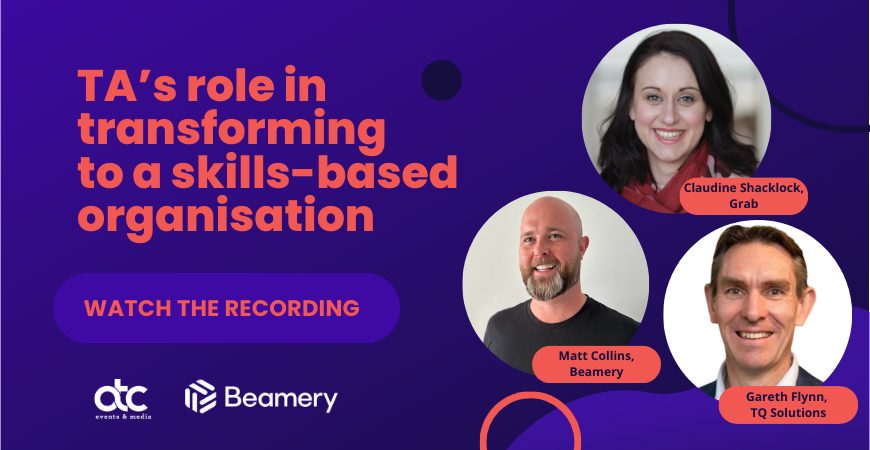Transforming to a skills-based organisation

As we move away from an era of “traditional jobs” and into the new, skills-based world of work, organisations are facing the fact that they need to re-engineer how they attract, retain, and manage talent.
But while a recent Beamery survey found that a staggering 90% of respondents in Australia believe that talent approaches must prioritise skills over traditional roles, only 25% of Australian leaders believe that this approach can effectively address the prevalent skills shortages in their businesses.
This disconnect shows there is a large gap in Australia between the acknowledgement of the power of skills, and the reluctance to embrace skills as a solution to business challenges.
Recently, TQSolution’s Director Gareth Flynn moderated a webinar with Beamery’s Asia Pacific Vice President Matt Collins and Grab’s Head of Employer Branding Claudine Shacklock to discuss the need for the skills transformation and the role that Talent Acquisition needs to play in transitioning to a skills-based organisation.
Watch Now: TA’s role in transforming to a skills-based organisation.
Recorded 17th October 2023. Download the slides.
A key takeaway from this discussion was the idea that companies need to adjust their thinking and approach old problems with new mindsets if they want to take advantage of the skills workforce model.
Here are some of the key points raised by the panellists about how talent teams, and the broader organisation, need to change up their approach
The concept of workforce planning has changed
Matt Collins, Asia Pacific Vice President, Beamery
Workforce planning used to be CFOs & COOs looking at job titles, performance metrics, and cost. That method will help you streamline your business and be more profitable in the short term, but it makes you much less agile, and much less flexible as a business. You become very reactive.
But there are a number of recent examples – particularly the recent tech sector layoffs – that businesses should learn from. Workforce planning is about more than just performance metrics.
There’s a story about this from “the large tech company” (I’m not going to name names!). When they were looking at reducing head count, they decided to get rid of the bottom 25% of performers. But as one HR member pointed out, how does that affect tenure? Is it that these people are underperforming because they’re brand new? And if it is, TA had made great strides to re-diversify the employer workforce over the last couple of years; would this company cause huge problems with their DEI community because we haven’t thought about the nuance and only looked at 1 top-level metric?
Skills unlocks a new way of workforce planning for the longer term. It’s not just “hey we’ve got 16 sales people, and we only need 13”. From those additional 3 people, it’s about looking at that person’s unique skillset and understanding where they could be re-deployed in the business elsewhere.
Hear Matt’s full answer at 38:09 in the recording above.
A new approach to skills-development
Claudine Shacklock, Head of Employer Branding, Grab
Personalisation is key.
Previously, Learning & Development (L&D) has been one-size-fits all. Companies would put a tonne of people in one training program, and hope for the best. But we know that spray and pray does not work! We need to be hyper targeted and segmented.
This is where the symbiotic relationship comes about of 1) understanding what the training needs are, and 2) understanding the needs and desires of the employees so you get the right people through the right training at the right time.
And the main benefit to the business? Cost. Because if you are being super targeted, and you’re helping people reach their development potential you’re not going to lose those people to other companies when you’ve so heavily invested in them so heavily anyway. You’ve given that person the right training at the right time for the right job that meets both the companies’ needs, and that employee’s needs as well.
Hear Claudine’s full answer at 32.16 in the recording above
It’s more than just data
Matt Collins, Vice President Asia Pacific, Beamery
Having a successful skills transformation relies on great data. Connecting different data sources and being able to use that is really important. But knowing how to use that is mission critical.
I think organisations sometimes look at tech as a silver bullet. They look at tech as a godsend, but there’s no replacement for hardwork and conscious thought process. You can tidy up all your data sources and get your data sets looking good, but all parties need to come together frequently – suppliers, clients, internal, everyone – and understand how to use that data.
The issues that occur from relying only on tech are things like using new technology but using old and outdated processes. Or lack of journey design work – who in the business takes part for certain parts of the process? Bad internal comms is another issue – once everything is up to date, does everyone know what it is, how to use it, or why they’re using it?
Ultimately, people need to know why they’re doing something. If you don’t communicate why you’re asking people to do something, there’s less chance they’ll do it which can put the project at risk.
Hear Matt’s full answer at 23:21 in the recording above.
Related articles
Leave a Reply
Sign up to our newsletter
Get a weekly digest on the latest in Talent Acquisition.
Deliver this goodness to my inbox!


